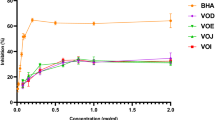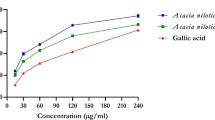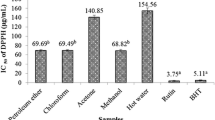Abstract
Fruit phenolics are important dietary antioxidant and antidiabetic constituents. The fruit parts (pulp, seed, seed coat, kernel) of underutilized indigenous six black jamun landraces (Syzygium cumini L.), found in Gir forest region of India and differed in their fruit size, shape and weight, are evaluated and correlated with antidiabetic, DPPH radical scavenging and phenolic constituents. The α-amylase inhibitors propose an efficient antidiabetic strategy and the levels of postprandial hyperglycemia were lowered by restraining starch breakdown. The sequential solvent systems with ascending polarity—petroleum ether, ethyl acetate, methanol and water were performed for soxhlet extraction by hot percolation method and extractive yield was found maximum with methanolic fruit part extracts of six landraces. The methanolic extracts of fruit parts also evidenced higher antidiabetic activity and hence utilized for further characterization. Among the six landraces, pulp and kernel of BJLR-6 (very small, oblong fruits) evidenced maximum 53.8 and 98.2% inhibition of α-amylase activity, respectively. The seed attained inhibitory activity mostly contributed by the kernel fraction. The inhibition of DPPH radical scavenging activity was positively correlated with phenol constituents. An HPLC–PDA technique was used to quantify the seven individual phenolics. The seed and kernel of BJLR-6 exhibited higher individual phenolics—gallic, catechin, ellagic, ferulic acids and quercetin, whereas pulp evidenced higher with gallic acid and catechin as α-amylase inhibitors. The IC50 value indicates concentration of fruit extracts exhibiting ≥50% inhibition on porcine pancreatic α-amylase (PPA) activity. The kernel fraction of BJLR6 evidenced lowest (8.3 µg ml−1) IC50 value followed by seed (12.9 µg ml−1), seed coat (50.8 µg ml−1) and pulp (270 µg ml−1). The seed and kernel of BJLR-6 inhibited PPA at much lower concentrations than standard acarbose (24.7 µg ml−1) considering good candidates for antidiabetic herbal formulations.
Graphical Abstract




Similar content being viewed by others
Abbreviations
- DPPH:
-
1,1-diphenyl-2-picrylhydrazyl
- NIDDM:
-
Non-insulin dependent diabetes mellitus
- WHO:
-
World health organization
- BJLR:
-
Black jamun landraces
- HPLC:
-
High-performance liquid chromatography
- DNSA:
-
Di-nitro salicylic acid
- PDA:
-
Photodiode array
- 2FCRD:
-
Two factor complete block randomized design
- PPA:
-
Porcine pancreatic α-amylase
- IC50 :
-
50% inhibition of enzyme activity
References
Afrin S, Gasparrini M, Forbes-Hernandez TY, Reboredo-Rodriguez P, Mezzetti B, Varela-López A, Giampieri F, Battino M (2016) Promising health benefits of the strawberry: a focus on clinical studies. J Agric Food Chem 64(22):4435–4449
Alberti KG, Zimmet PZ (1998) Definition diagnosis and classification of diabetes mellitus and its complications. Part 1: diagnosis and classification of diabetes mellitus. Report of a WHO Consultation. Diabet Med 15:534–539
Ali H, Houghton P, Soumyanath A (2006) α-Amylase inhibitory activity of some Malaysian plants used to treat diabetes; with particular reference to Phyllanthus amarus. J Ethnopharmacol 107:449–455
Anandharajan R, Jaiganesh S, Shankernarayanan N, Viswakarma R, Balakrishnan A (2006) In vitro glucose uptake activity of Aegles marmelos and Syzygium cumini by activation of Glut-4, PI3 kinase and PPAR. Phytomedicine 13:434–441
Atale N, Jaiswal A, Chhabra A, Malhotra U, Kohli S, Mohanty S, Rani V (2011) Phytochemical and antioxidant screening of Syzygium cumini seed extracts: a comparative study. J Pharm Res 4(12):4530–4532
Ayyanar M, Subash-babu P (2012) Syzygium cumini (L.) Skeels: a review of its phytochemical constituents and traditional uses. Asian Pac J Trop Biomed 2:240–246
Balasubashini M, Rukkumani R, Menon V (2003) Protective effects of ferulic acid on hyperlipidemic diabetic rats. Acta Diabetol 40:118–122
Banerjee A, Nabasree D, Bratati D (2005) In vitro study of antioxidant activity of Syzygium cumini fruit. Food Chem 90:727–733
Benherlal P, Arumughan C (2007) Chemical composition and in vitro antioxidant studies on Syzygium cumini fruit. J Sci Food Agric 87:2560–2569
De Bona KS, Bonfanti G, Bitencourt PE, da Silva TP, Borges RM, Boligon A, Pigatto A, Athayde ML, Moretto MB (2016) Protective effect of gallic acid and Syzygium cumini extract against oxidative stress-induced cellular injury in human lymphocytes. Drug Chem Toxicol 39(3):256–263
Edirisinghe I, Burton-Freeman B (2016) Anti-diabetic actions of Berry polyphenols—review on proposed mechanisms of action. J Berry Res 6:237–250
Eichler H, Korn A, Gasic S (1984) The effect of a new specific α-amylase inhibitor on post-prandial glucose and insulin excursions in normal and Type 2 (non-insulindependent) diabetic patients. Diabetologia 26:278–281
Forbes-Hernandez TY, Gasparrini M, Afrin S, Bompadre S, Mezzetti B, Quiles JL, Giampieri F, Battino M (2016) The healthy effects of strawberry polyphenols: Which strategy behind antioxidant capacity? Crit Rev Food Sci Nutr 56(1):S46–S59
Gajera HP, Kapopara MB, Patel VH, Patel MM (2008) Influence of peanut butter on quality characteristics of biscuits. J Food Sci Technol 45(4):373–375
Gajera HP, Kapopara MB, Patel VH (2010) Application of peanut butter to improve fatty acid composition of biscuits. J Food Sci Technol 47(3):285–289
Grover J, Vats V, Rathi S (2000) Anti-hyperglycemic effect of Eugenia jambolana and Tinospora cordifolia in experimental diabetes and their effects on key metabolic enzymes involved in carbohydrate metabolism. J Ethnopharmacol 73:461–470
Gupta M, Sasmal S, Majumandar S, Mukherjee A (2012) HPLC profile of standard phenolics compounds present in medicinal plant. Int J Pharmacol 4:162–167
Hasan R, Mokarram M, Raushanara A, Mariam J, Ehsanul H, Mazumder N, Shafiqur R (2009) DPPH free radical scavenging activity of some Bangladeshi medicinal plants. J Med Plants Res 3:875–879
Hossain H, Rahman SE, Akbar PN, Khan TA, Rahman M, Jahan IR (2016) HPLC profiling, antioxidant and in vivo anti-inflammatory activity of the ethanol extract of Syzygium jambos available in Bangladesh. BMC Res Notes 9:191–198
Hussain SA, Ahmed ZA, Mahwi TO, Aziz TA (2012) Quercetin dampens postprandial hyperglycemia in type 2 diabetic patients challenged with carbohydrates load. Int J Diabetes Res 1:32–35
Jayasinghe C, Gotoh N, Aoki T, Wada S (2003) Phenolic composition and antioxidant activity of Sweet Basil. J Agric Food Chem 51:4442–4449
Jo SH, Ka EH, Lee HS (2009) Comparison of antioxidant potential and rat intestinal α-glucosidases inihibitory activities of quercetin, rutin, and isoquercetin. Int J Appl Res Nat Prod 2:52–60
Joshi C, Priya E, Venkataraman S (2007) Hypoglycemic and antilipidperoxidative effects of a polyherbal formulation, Diakyur, in experimental animal models. J Health Sci 53:734–739
Jung EH, Kim SR, Hwang IK, Ha TY (2006a) Hypoglycemic effects of a phenolic acid fraction of rice bran and ferulic acid in C57BL/KsJ-db/db mice. J Agric Food Chem 55:980–984
Jung UJ, Lee MK, Park YB, Jeon SM, Choi MS (2006b) Antihyperglycemic and antioxidant properties of caffeic acid in db/db mice. J Pharmacol Exp Ther 318:476–483
Kotowaroo MI, Mahomoodally MF, Gurib-Fakim A, Subratty AH (2006) Screening of traditional antidiabetic medicinal plants of Mauritius for possible α-amylase inhibitory effects in vitro. Phytother Res 20:228–231
Liang LZ, Yi ML (2009) Antioxidant tannins from Syzygium cumini fruit. Afr J Biotechnol 8:2301–2309
Luximon RA, Bahorun T, Crozier A (2003) Antioxidant actions and phenolic and vitamin C contents of common Mauritian exotic fruits. J Sci Food Agric 83:496–502
Mazzoni L, Perez-Lopez P, Giampieri F, Alvarez-Suarez JM, Gasparrini M, Forbes-Hernandez TY, Quiles JL, Mezzetti B, Battino M (2016) The genetic aspects of berries: from field to health. J Sci Food Agric 96(2):365–371
McCune L, Johns T (2002) Antioxidant activity in medicinal plants associated with the symptoms of diabetes mellitus used by the indigenous peoples of the North American boreal forest. J Ethnopharmacol 82:197–205
Meguro S, Nagao T, Hase T, Otsuka K, Komikado M, Tokimitsu I, Yamamoto T, Yamamoto K (2009) A catechin-rich beverage improves obesity and blood glucose control in patients with type 2 diabetes. Obesity (Silver Spring) 17:310–317
Meshram G, Yadav S, Dattatraya S, Patil B, Singh D (2011) Antibacterial study and effect of ethanolic extracts of Syzygium cumini seeds powder on glucoamylase in vitro. J Pharm Sci Res 3:1060–1063
Miller GL (1959) Use of dinitrosalicylic acid reagent for determination of reducing sugar. Anal Chem 31:426–428
Morita M, Naito Y, Yoshikawa T, Niki E (2017) Antioxidant capacity of blueberry extracts: peroxyl radical scavenging and inhibition of plasma lipid oxidation induced by multiple oxidants. J Berry Res 7(1):1–9
Mukherjee P, Maiti K, Mukherjee K, Houghton PJ (2006) Leads from Indian medicinal plants with hypoglycaemic potentials. J Ethnopharmacol 106:1–28
Muniappan A, Pandurangan P, Subash B (2012) Syzygium cumini (L.) Skeels: a review of its phytochemical constituents and traditional uses. Asian Pac J Trop Biomed 3:240–246
Muthumani P, Ramseshu KV, Meera R, Devi P (2010) Phytochemical investigation and anti microbial and enzyme inhibition activity of Murraya Koenigii (Linn) spreng. Int J Pharm Biol Sci Arch 1(4):345–349
Nomura H (2001) Acceleration of ferulic acid and related compounds on insulin secession. Research report of Wakayama industrial technology center, pp 17–19
Patwardhan B, Vaidya D, Chorghade M (2004) Ayurveda and natural products drug discovery. Curr Sci 86:789–799
Ponnusamy S, Ravindran R, Zinjarde S, Bhargava S, Kumar A (2010) Evaluation of traditional indian antidiabetic medicinal plants for human pancreatic amylase inhibitory effect in vitro. Evid Based Complement Altern Med 4:401–407
Prior RL, Sintara M, Chang T (2016) Multi-radical (ORAC) antioxidant capacity of selected berries and effects of food processing MR5. J Berry Res 6:159–173
Rahman MA, Moon SS (2007) Antioxidant polyphenol glycosides from the Plant Draba nemorosa. Bull Korean Chem Soc 28:827–831
Rizvi SI, Zaid MA, Anis R, Mishra N (2005) Protective role of tea catechins against oxidation-induced damage of type 2 diabetic erythrocytes. Clin Exp Pharmacol Physiol 32:70–75
Rosen OM (1987) After insulin binds. Science 237:1452–1458
Roy G, Malla S, Chakravarty S (2013) Integrated processing of jamun (Syzygium cumini Skeels) fruit for value addition and assessment of its impact on health and nutrition. Clin Diagn Lab Immunol 21:65–69
Snedecor GW, Cochran WG (1967) Statistical methods, 6th edn. Oxford and IBH Publishing Co., Culcatta
Stanely M, Prince M, Kumar C, Selvakumari J (2011) Effects of gallic acid on brain lipid peroxide and lipid metabolism in streptozotocin-induced diabetic Wistar rats. J Biochem Mol Toxicol 25:101–107
Van Dam RM (2006) Coffee and type 2 diabetes: from beans to beta-cells. Nutr Metab Cardiovasc Dis 16:69–77
Zhi PR, Liang LZ, Yi ML (2008) Evaluation of the antioxidant activity of Syzygium cumini leaves. Molecules 13:2545–2556
Author information
Authors and Affiliations
Corresponding author
Electronic supplementary material
Below is the link to the electronic supplementary material.
Rights and permissions
About this article
Cite this article
Gajera, H.P., Gevariya, S.N., Hirpara, D.G. et al. Antidiabetic and antioxidant functionality associated with phenolic constituents from fruit parts of indigenous black jamun (Syzygium cumini L.) landraces. J Food Sci Technol 54, 3180–3191 (2017). https://doi.org/10.1007/s13197-017-2756-8
Revised:
Accepted:
Published:
Issue Date:
DOI: https://doi.org/10.1007/s13197-017-2756-8




